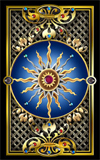More About the Tarot and Cartomancy
The world of tarot and cartomancy is a realm of symbolism, mystique, and ancient wisdom. These practices have captured the human imagination for centuries, offering glimpses into the past, present, and future. In this exploration, we'll journey into the intriguing world of tarot and cartomancy, uncovering their origins, methodologies, and fascinating curiosities.A Brief History of Tarot and Cartomancy
Tarot cards, often associated with mystical readings and fortunetelling, have a history that dates back to the 15th century. Originally designed as a card game in Europe, they later evolved into a divination tool. A standard tarot deck consists of 78 cards, with two main categories: the Major Arcana (22 cards) and the Minor Arcana (56 cards). Each card carries its symbolism and meaning, making it a versatile tool for divination and introspection.
Cartomancy, on the other hand, is the art of fortune telling using regular playing cards. This practice is even older, with its origins traced back to the 14th century. Cartomancers interpret the cards' suits, numbers, and combinations to provide insights into one's life and future.
The Enigmatic Major Arcana
Within the tarot, the Major Arcana cards hold a special place. Each of the 22 cards in this category represents a significant life event, archetype, or symbol. Here are a few intriguing Major Arcana cards:
1. The Fool: Representing new beginnings, this card is often associated with a carefree, adventurous spirit. It symbolizes taking risks and embracing change.
2. The Hanged Man: This card challenges conventional thinking and invites a new perspective. It encourages letting go of preconceived notions and seeing things from a different angle.
3. The Tower: A symbol of sudden upheaval and change, this card often indicates unexpected events or revelations.
4. The World: The final card of the Major Arcana, it signifies fulfillment and the realization of a long-held goal. It represents a sense of completion and accomplishment.
Curiosities of Tarot and Cartomancy
1. The Rider-Waite Tarot Deck: Created by artist Pamela Colman Smith and occultist A.E. Waite in 1910, the Rider-Waite Tarot deck is one of the most widely recognized and used tarot decks in the world. Its rich symbolism and imagery have made it a favorite among tarot enthusiasts.
2. Tarot as a Mirror: Many tarot readers consider tarot cards as a reflection of the subconscious mind. The cards are believed to tap into the reader's intuition and provide insights into the querent's (the person seeking a reading) life.
3. Fortune Telling with Playing Cards: Cartomancy is not limited to tarot cards. Playing cards are also used for divination. Each of the four suits (hearts, diamonds, clubs, and spades) is associated with different aspects of life.
4. Tarot and Psychology: Some psychologists and therapists incorporate tarot into their practices as a therapeutic tool. Tarot readings are used to facilitate self-reflection, insight, and personal growth.
5. Tarot in Pop Culture: Tarot cards have made their way into popular culture, appearing in books, movies, and even video games. They often serve as symbols of mystery, destiny, and hidden knowledge. 6. The Tarot Deck's Mysterious Origins: The origins of the tarot deck are still a subject of debate among scholars. Some believe it has connections to ancient Egypt, while others associate it with the Italian Renaissance.
The Art of Interpretation
Both tarot and cartomancy rely on the interpretation of card combinations and their significance. Skilled readers draw upon their intuition, knowledge of symbolism, and the specific question or context to provide insights and guidance.
In tarot, the positions of the cards in a spread, their relationship to each other, and their proximity to the querent's birth sign all contribute to the interpretation. The reader's intuition plays a significant role in the process, allowing for a personalized and insightful reading.
Ethical Considerations
While tarot and cartomancy can be sources of guidance and inspiration, it's essential to approach them with an ethical mindset. Readers should provide readings that are empowering, compassionate, and non-predictive of harm. Tarot and cartomancy should not be used to manipulate or exploit individuals.
In Conclusion
The world of tarot and cartomancy is a captivating blend of history, symbolism, and personal insight. Whether you're drawn to the enigmatic Major Arcana cards or the subtle art of cartomancy with playing cards, these practices offer a unique lens through which to explore the human experience. The key to a meaningful reading lies in the skilled interpretation and the sincere quest for understanding. As we navigate the grand tapestry of life, these ancient tools can provide guidance and contemplation on our journey.
Select your cards









































